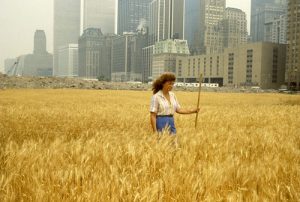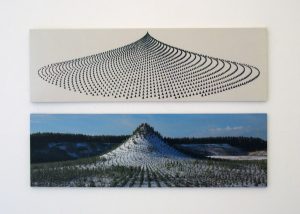Kristine Carreon “Agnes Denes and her Ecological Artworks”
Kristine Carreon
Preface
My name is Kristine Carreon. The title of this work is “Agnes Denes and her Ecological Artworks.” For this project, I will be using a CC BY-NC-ND license.
Introduction
Agnes Denes is known to many as a pioneer for several art movements, including environmental art. She emerged in the 1960s and 1970s as an artist who focused on socio-political ideas while exploring the creation of art that dealt with science, philosophy, linguistics, psychology, poetry, history, and music. Her art often combines nature with social and ecological concerns that are still prevalent today while implementing natural resources in her art pieces.
Themes
Two significant themes show up in Denes’ work. The first theme is humanity. Denes’ art often emphasizes the relationship between human beings and the natural world. Her artwork questions the ecological well-being of the world, and how humans contribute to the degradation of Earth’s natural environment and future quality of life. The second theme is urbanization. As the world’s population continues to grow, rural areas are turning into urban areas. Many of Denes’ artwork includes maintaining the natural environment and ecological life, allowing people to consider the impact of their actions and how they can interact with the land to protect its natural environment.
Analysis

Wheatfield – A Confrontation is Denes’ most known work of art. In 1982, two acres of land were devoted to Denes’ use as a wheatfield in lower Manhattan. According to Denes, she said that the wheatfield represented “food, energy, commerce, world trade, and economics,” calling to ecological concerns in urbanized areas and the growth of globalization. The wheat that was harvested was distributed to 28 cities around the world, providing people with seeds they could plant; the hay was given to police horses in Manhattan. This distribution of food brought food shortages and many inequalities to the limelight. This shows the importance of world hunger and lets people think about the future of humanity and how their actions lead them to face their own consequences.

The Living Pyramid is a New York-based art piece finished in 2015 and can be seen in Socrates Sculpture Park in Long Island City, Queens; this is Denes’ first New York-based land art since Wheatfield – A Confrontation. For this art piece, Denes studied mathematics, history, and ecology, which are foundational for philosophical and social curiosities. The Living Pyramid is part of a collection of Denes’ pyramid models, which examines the significance of the environment and its relationship with social hierarchies; those higher up on the social hierarchy tend to ignore ecological and environmental concerns, showing ignorance of posterity’s standard of living. Since Denes has experienced sexism throughout her life and as an artist, some conclude that The Living Pyramid symbolizes her “creative fecundity and life force.”

Tree Mountain – A Living Time Capsule was built between the years of 1992 and 1996; Denes planted 11,000 trees with the help of 11,000 people in Ylojarvi, Finland. The Finnish government allowed the project to occur to raise awareness of the world’s ecological stress. Denes created Tree Mountain to remind future generations of people’s environmental legacies in the commitment to ecological, social, and cultural life on Earth. Today, Tree Mountain is considered a virgin forest, or protected land, by the United Nations Environment Program and the Finnish Ministry of the Environment. It provides wildlife with a home and allows for a thriving, natural environment.
Application
In the 1960s and 1970s, Agnes Denes contributed heavily to the conception of environmental art; she considered how humans must know the consequences of their own actions regarding the sustainability of the natural environment and drew attention to potential ecological disasters. These values of Denes’ work are still prominent in modern-day, as there are many concerns and worries worldwide about the future of Earth. Denes’ artwork also includes large-scale projects that are hard to miss, ensuring her messages are clearly heard.
Works Cited
- “Agnes Denes.” Socrates Sculpture Park, 2015, socratessculpturepark.org/artist/agnes-denes/.
- Kalela, Aira. “Tree Mountain – A Living Time Capsule-11,000 Trees, 11,000 People, 400 Years, 1992-96, (420 x 270 x 28 Meters) Ylojarvi, Finland.” Agnes Denes Studio, 1996, www.agnesdenesstudio.com/works4.html.
- McCoy, Ann. “Agnes Denes Living Pyramid.” The Brooklyn Rail, Sept. 2015, brooklynrail.org/2015/09/artseen/agnes-denes-living-pyramid.
- “The Living Pyramid.” Agnes Denes Studio, 2017, www.agnesdenesstudio.com/works13_LivingPyramid.html.
- “The Living Pyramid – Socrates Sculpture Park.” Socrates Sculpture Park, May 2015, socratessculpturepark.org/exhibition/pyramid/.
- “Wheatfield – A Confrontation: Battery Park Landfill, Downtown Manhattan.” Agnes Denes Studio, 11 Sept. 2001, www.agnesdenesstudio.com/works7.html.
Media Attributions
- 3649668063_a0713fbf63
- 21840000150_5066c93af9_b
- 518300581_256876f535_b

